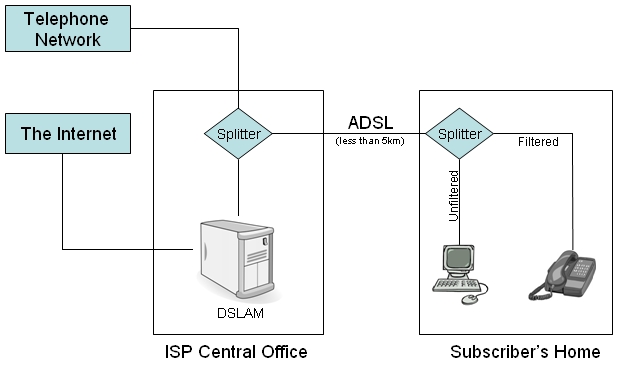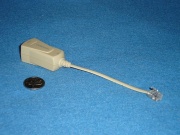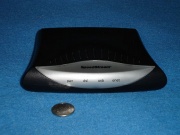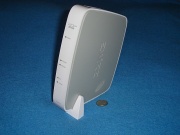Asymmetric Digital Subscriber Line
From Computing and Software Wiki
(→'''Functionality''') |
|||
| Line 22: | Line 22: | ||
{|align="right" | {|align="right" | ||
|- | |- | ||
| - | | [[Image: | + | | [[Image:ADSL_Physical.jpg|Frequency Usage in ADSL]] |
|} | |} | ||
ADSL differs from standard DSL in that the data flow is asymmetric; the data flow is greater in one direction. This is due to the observation that most people use the Internet in a fairly passive fashion. Requests are made for websites or files, which are then downloaded from the Internet. The size of the site/file requests is small relative to the files and websites they are downloading. As the Internet grows, so too does the size of the files people are downloading, and the size of the websites they are visiting. It makes sense that users should have a greater ability to download and view these files. In fact, even though the upload pipeline is very small, it has only recently begun to be used to its full bandwidth. The advent of technologies such as Bit Torrent, which focuses on equal uploading and downloading, has finally begun to use the full upload bandwidth. | ADSL differs from standard DSL in that the data flow is asymmetric; the data flow is greater in one direction. This is due to the observation that most people use the Internet in a fairly passive fashion. Requests are made for websites or files, which are then downloaded from the Internet. The size of the site/file requests is small relative to the files and websites they are downloading. As the Internet grows, so too does the size of the files people are downloading, and the size of the websites they are visiting. It makes sense that users should have a greater ability to download and view these files. In fact, even though the upload pipeline is very small, it has only recently begun to be used to its full bandwidth. The advent of technologies such as Bit Torrent, which focuses on equal uploading and downloading, has finally begun to use the full upload bandwidth. | ||
| Line 31: | Line 31: | ||
<br clear=all/> | <br clear=all/> | ||
| + | |||
== '''The Future of ADSL''' == | == '''The Future of ADSL''' == | ||
{|align="right" | {|align="right" | ||
Revision as of 00:24, 14 April 2008
ADSL (Asymmetric Digital Subscriber Line) is one of the leading methods of providing high-speed Internet service to subscribers. ADSL is a variant of DSL, with the A standing for Asymmetric, not Asynchronous as many people incorrectly believe it to be. The service is said to be asymmetric because the available upstream bandwidth is much less than the downstream bandwidth. Though there are some limitations imposed on the technology such as maximum bandwidth, and maximum distance from the Central Office, ADSL continues to be a competitive force in the Internet service market.
ADSL provides much greater bandwidth than traditional voiceband modems, but does so while utilizing the same copper phone lines.
Contents |
History
Historically internet was served to people's homes through the use of voice frequency data modems connect to the existing copper telephone line network. This network consists of twister pair copper wires which run back to the telephone company's central office. The voice frequency data modem made use of the same frequencies as human speech, up to about 3.4kHz, and as such was only able to achieve speeds of up to 56Kbps. This also had the disadvantage of tying up the phone line whenever the modem was in use. ADSL makes use of other frequencies which are not needed by traditional telephony services, allowing an ADSL signal to exist on a copper line in addition to a voice signal. Traditionally when ADSL was run to a home, a whole home splitter was installed at the demarkation point (???), where the phone line comes in from the street to the home. The splitter would filter all exisiting phone lines in the home, and provide an unfiltered line for use by the ADSL modem. This approached proved to be rather expensive for the ISP as they would have to cover the cost of the splitter, as well as the technician who would go out and do the installation. Most ISPs have now adopted a much more passive stance where they ship the ADSL modem with a number of microfilters which users will have to place on each of their telephones. While cheaper for this ISP, this can lead to degredation of service of the consumer if they have more than X telephonic devices in their home. The reason for this is that the branching of the various phone lines causes reflections, which interfere with the ADSL signal. A whole home splitter solves this problem in that there are no reflections; the ADSL modem is connected directly to the splitter, and is alone on an unfiltered line.
Functionality

|
ADSL differs from standard DSL in that the data flow is asymmetric; the data flow is greater in one direction. This is due to the observation that most people use the Internet in a fairly passive fashion. Requests are made for websites or files, which are then downloaded from the Internet. The size of the site/file requests is small relative to the files and websites they are downloading. As the Internet grows, so too does the size of the files people are downloading, and the size of the websites they are visiting. It makes sense that users should have a greater ability to download and view these files. In fact, even though the upload pipeline is very small, it has only recently begun to be used to its full bandwidth. The advent of technologies such as Bit Torrent, which focuses on equal uploading and downloading, has finally begun to use the full upload bandwidth.
Traditional voice telephony only utilizes a very small portion of the possible bandwidth in a copper wire. In fact, all voiceband communications fall within the range between 0 and 4kHz. ADSL makes use of the higher frequencies supported by the copper wire. There is an unused buffer area between 4kHz and 28.875kHz. The range from 28.875kHz to 138kHz is used for upstream transmission, while the region from 138kHz to 1104kHz is used for downstream. ADSL is a full duplex technology, which means that signals can be traveling in opposite directions at the same time, on a single wire.
Each of the two frequency ranges is further sub-divded into smaller units, called channels, which span approximately 4kHz. When an ADSL link is first established the modem on the user end and the DSLAM on the provider end test the various channels on the line to establish which channels have the best signal-to-noise ration, a messure of how much interference exists in that channel versus how strong the ADSL signals are. Interference in a channel can come from poor wire quality, noise on the line, or even AM radio signals (a copper phone line can be thought of as a large antenae). Once the best channels are determined, these channels are used for communication. If the signal ever becomes degraded to the point that communication is no longer possible, the channels are re-evaluated. It should be noted, however, that the amount of avaialable bandwidth drecreases with each unusable channel.
The Future of ADSL
In recent years ADSL has enjoyed a huge surge in popularity. As the Internet grows and the demand for streaming video and other such high bandwidth applications increases, voiceband technology has been all but abandoned in favour of highspeed internet. Due to the ease of installation, and the fact that it unilizes technology already present in every home with a telephone, ADSL has become extremely popular.
In the coming years, ADSL service providers will continue to expand their coverage. As things stand at the moment, ADSL is only available in densely populated areas, and even then there are gaps in the service. This stems from the fact that the ADSL signal degrades rapidly and becomes unstable at distances great than 5km. Service providers are solving this problem by running fiber optic lines from the central office to remote DSLAMs in locations where service was previously unavailable. The practice can also increase the speeds available to people who already fall within an ADSL service area by connecting them to a DSLAM which is closer to their home (for instance if they were previously being served from a DSLAM 4.5km away,and a new one is installed less than 1km distant).
Despite its recently surge, however, when one looks to the future of ADSL over the next ten years, the outlook does not look good. New technologies are emerging that could eclipse and even replace ADSL altogether. Some ISPs have already begun to roll out the sucessor to ADSL, ADSL2, which features greater bandwidth and speeds through the use of greater frequency ranges. However, even the new ADSL2 is eclipsed by the emerging VDSL (also known as VHDSL). VDSL, Very High Speed Digital Subscriber Line, provides speeds up to 100Mbits/s in both directions through the utilization of frequencies up to 30MHz. Though it is still an emerging technology in the Western world, VDSL has seen widesread adoption in Japan and South Korea where it is the predominant highspeed internet technology.
See Also
References
- http://http://en.wikipedia.org/wiki/Adsl
- http://electronics.howstuffworks.com/vdsl1.htm
- http://electronics.howstuffworks.com/vdsl3.htm
- http://www2.rad.com/networks/2005/adsl/main.htm
- http://www.esatclear.ie/~aodhoh/adsl/report.html
- http://en.wikipedia.org/wiki/VDSL
External Links
--Durandal 10:47, 9 April 2008 (EDT)



